History of Western civilization
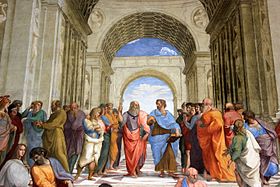
Following the 5th century
The Industrial Revolution began in Britain in the 18th century. Under the influence of the Enlightenment, the Age of Revolution emerged from the United States and France as part of the transformation of the West into its industrialised, democratised modern form. The lands of North and South America, South Africa, Australia and New Zealand became first part of European empires and then home to new Western nations, while Africa and Asia were largely carved up between Western powers. Laboratories of Western democracy were founded in Britain's colonies in Australasia from the mid-19th centuries, while South America largely created new autocracies. In the 20th century, absolute monarchy disappeared from Europe, and despite episodes of Fascism and Communism, by the close of the century, virtually all of Europe was electing its leaders democratically. Most Western nations were heavily involved in the First and Second World Wars and protracted Cold War. World War II saw Fascism defeated in Europe, and the emergence of the United States and Soviet Union as rival global powers and a new "East-West" political contrast.
Other than in Russia, the European empires disintegrated after World War II and
Antiquity: before AD 500
The Middle Ages
Early Middle Ages: 500–1000
While the Roman Empire and Christian religion survived in an increasingly Hellenised form in the Byzantine Empire centered at Constantinople in the East, Western civilization suffered a collapse of literacy and organization following the fall of Rome in AD 476. Gradually however, the Christian religion re-asserted its influence over Western Europe.
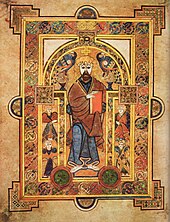

After the
Pope Gregory the Greatmade himself in Italy a power stronger than emperor or exarch, and established a political influence which dominated the peninsula for centuries. From this time forth the varied populations of Italy looked to the pope for guidance, and Rome as the papal capital continued to be the center of the Christian world.
According to tradition, it was a Romanized Briton, Saint Patrick who introduced Christianity to Ireland around the 5th century. Roman legions had never conquered Ireland, and as the Western Roman Empire collapsed, Christianity managed to survive there. Monks sought out refuge at the far fringes of the known world: like Cornwall, Ireland, or the Hebrides. Disciplined scholarship carried on in isolated outposts like Skellig Michael in Ireland, where literate monks became some of the last preservers in Western Europe of the poetic and philosophical works of Western antiquity.[12]
By around 800 they were producing illuminated manuscripts such as the Book of Kells. The missions of Gaelic monasteries led by monks like St Columba spread Christianity back into Western Europe during the Middle Ages, establishing monasteries initially in northern Britain, then through Anglo-Saxon England and the Frankish Empire during the Middle Ages. Thomas Cahill, in his 1995 book How the Irish Saved Civilization, credited Irish Monks with having "saved" Western Civilization during this period.[13] According to art historian Kenneth Clark, for some five centuries after the fall of Rome, virtually all men of intellect joined the Church and practically nobody in western Europe outside of monastic settlements had the ability to read or write.[12]
Around AD 500,
Only in 732 was the
Charlemagne ("Charles the Great" in English) became king of the Franks. He conquered Gaul (modern day France), northern Spain, Saxony, and northern and central Italy. In 800, Pope Leo III crowned Charlemagne Holy Roman Emperor. Under his rule, his subjects in non-Christian lands like Germany converted to Christianity.
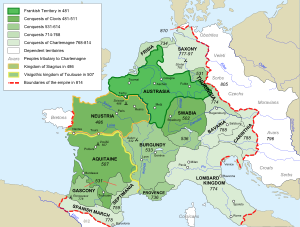
After his reign, the empire he created broke apart into the kingdom of France (from Francia meaning "land of the Franks"), Holy Roman Empire and the kingdom in between (containing modern day Switzerland, northern-Italy, Eastern France and the low-countries).
Starting in the late 8th century, the
By the beginning of the 11th century Scandinavia was divided into three kingdoms, Norway, Sweden, and Denmark, all of which were Christian and part of Western civilization.
In the 10th century another marauding group of warriors swept through Europe, the
A West Slavic people, the Poles, formed a unified state by the 10th century and having adopted Christianity also in the 10th century[15][16] but with pagan rising in the 11th century.
By the start of the second millennium AD, the West had become divided linguistically into three major groups. The
High Middle Ages: 1000–1300
Art historian
By the year 1000
In 1054, after centuries of strained relations, the
As the Medieval period progressed, the aristocratic military ideal of
Women were in many respects excluded from political and mercantile life, however, leading churchwomen were an exception. Medieval abbesses and female superiors of monastic houses were powerful figures whose influence could rival that of male bishops and abbots: "They treated with kings, bishops, and the greatest lords on terms of perfect equality;. . . they were present at all great religious and national solemnities, at the dedication of churches, and even, like the queens, took part in the deliberation of the national assemblies...".
In 1095,
After the
In
Relations between the major powers in Western society: the nobility,
From the 12th century onward inventiveness had re-asserted itself outside of the Viking north and the Islamic south of Europe. Universities flourished, mining of coal commenced, and crucial technological advances such as the
Late Middle Ages: 1300–1500
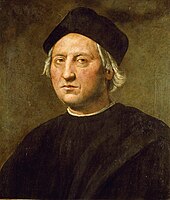


A cooling in temperatures after about 1150 saw leaner harvests across Europe and consequent shortages of food and flax material for clothing. Famines increased and in 1316 serious famine gripped Ypres. In 1410, the last of the Greenland Norseman abandoned their colony to the ice. From
The
In the
The last centuries of the Middle Ages saw the waging of the Hundred Years' War between England and France. The war began in 1337 when the king of France laid claim to English-ruled Gascony in southern France, and the king of England claimed to be the rightful king of France. At first, the English conquered half of France and seemed likely to win the war, until the French were rallied by a peasant girl, who would later become a saint, Joan of Arc. Although she was captured and executed by the English, the French fought on and won the war in 1453. After the war, France gained all of Normandy excluding the city of Calais, which it gained in 1558.
Following the Mongols from Central Asia came the
Probably the first clock in Europe was installed in a Milan church in 1335, hinting at the dawning mechanical age.
Renaissance and Reformation
The Renaissance: 14th to 17th century


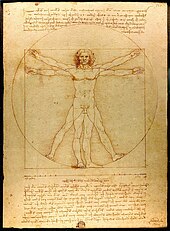

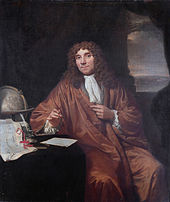
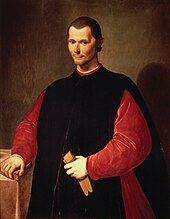
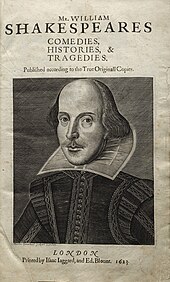
The Renaissance, originating from Italy, ushered in a new age of scientific and intellectual inquiry and appreciation of ancient Greek and Roman civilizations. The merchant cities of Florence, Genoa, Ghent, Nuremberg, Geneva, Zürich, Lisbon and Seville provided patrons of the arts and sciences and unleashed a flurry of activity.
The
Humanist historian Leonardo Bruni, split the history in the antiquity, Middle Ages and modern period.
Churches began being built in the Romanesque style for the first time in centuries. While art and architecture flourished in Italy and then the Netherlands, religious reformers flowered in Germany and Switzerland; printing was establishing itself in the Rhineland and navigators were embarking on extraordinary voyages of discovery from Portugal and Spain.[14]
Around 1450,
As the calendar reached the year 1500, Europe was blossoming – with
For the first time in European history, events North of the Alps and on the Atlantic Coast were taking centre stage.
Meanwhile, the Christian kingdoms of northern Iberia continued their centuries-long fight to
From the East, however, the Ottoman Turks under Suleiman the Magnificent continued their advance into the heart of Christian Europe — besieging Vienna in 1529.[14]
The 16th century saw the flowering of the Renaissance in the rest of the West. In the
The Reformation: 1500–1650

The other major movement in the West in the 16th century was the
In the 1540s the Frenchman
Britain and the Dutch Republic allowed Protestant dissenters to migrate to their North American colonies – thus the future United States found its early Protestant ethos – while Protestants were forbidden to migrate to the Spanish colonies (thus South America retained its Catholic hue). A more democratic organisational structure within some of the new Protestant movements – as in the Calvinists of New England – did much also to foster a democratic spirit in Britain's American colonies.[14]
The Catholic Church responded to the Reformation with the
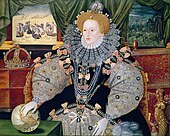
As princes, kings and emperors chose sides in religious debates and sought national unity, religious wars erupted throughout Europe, especially in the Holy Roman Empire. Emperor Charles V was able to arrange the Peace of Augsburg between the warring Catholic and Protestant nobility. However, in 1618, the Thirty Years' War began between Protestants and Catholics in the empire, which eventually involved neighboring countries like France. The devastating war finally ended in 1648. In the Peace of Westphalia ending the war, Lutheranism, Catholicism and Calvinism were all granted toleration in the empire. The two major centers of power in the empire after the war were Protestant Prussia in the north and Catholic Austria in the south. The Dutch, who were ruled by the Spanish at the time, revolted and gained independence, founding a Protestant country. The Elizabethan era is famous above all for the flourishing of English drama, led by playwrights such as William Shakespeare and for the seafaring prowess of English adventurers such as Sir Francis Drake. Her 44 years on the throne provided welcome stability and helped forge a sense of national identity. One of her first moves as queen was to support the establishment of an English Protestant church, of which she became the Supreme Governor of what was to become the Church of England.
By 1650, the religious map of Europe had been redrawn: Scandinavia, Iceland, north Germany, part of Switzerland, Netherlands and Britain were Protestant, while the rest of the West remained Catholic. A byproduct of the Reformation was increasing literacy as Protestant powers pursued an aim of educating more people to be able to read the Bible.
Rise of Western empires: 1500–1800
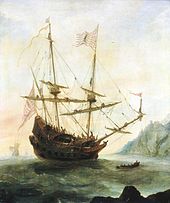

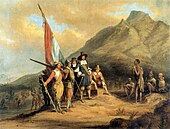
From its dawn until modern times, the West had suffered invasions from Africa, Asia, and non-Western parts of Europe. By 1500 Westerners took advantage of their new technologies, sallied forth into unknown waters, expanded their power and the Age of Discovery began, with Western explorers from seafaring nations like Portugal and Castile (later Spain) and later Holland, France and England setting forth from the "Old World" to chart faraway shipping routes and discover "new worlds".
In 1492, the
The Americas were deeply affected by European expansion, due to conquest, sickness, and introduction of new technologies and ways of life. The Spanish
Other European colonial powers followed in their wake, most prominently the English, Dutch, and French. All three nations established colonies through North and South America and the West Indies. English colonies were established on Caribbean islands such as Barbados, Saint Kitts and Antigua and on North America (largely through a proprietary system) in regions such as Maryland, Massachusetts and Rhode Island. Dutch and French colonization efforts followed a similar pattern, focusing on the Caribbean and North America. The islands of Aruba, Curaçao and Sint Maarten gradually came under Dutch control, while the Dutch established the colony of New Netherland in North America. France gradually colonized Louisiana and Quebec during the 17th and 18th centuries, and transformed its West Indian colony of Saint-Domingue into the wealthiest European overseas possession in the 18th century through a slave-based plantation economy.[27]
In the Americas, it seems that only the most remote peoples managed to stave off complete assimilation by Western and Western-fashioned governments. These include some of the northern peoples (i.e.,
Contact between the Old and New Worlds produced the
As European settlers began to colonize the Americas, numerous cash crop plantations sprung up to accommodate increasing demand in Europe. Initially, the labour source of these plantations came from European indentured servants; however, soon this system was supplemented by enslaved Africans imported by European slavers from Africa to the Americas via the transatlantic slave trade. Roughly 12 million enslaved Africans were forcibly transported to the Americas, primarily to the West Indies and South America. Once there, they were primarily forced to work on these plantations in brutal conditions, cultivating crops such as sugar, cotton and tobacco. Together with European trade to Africa and American trade to Europe, this trade was known as the "triangular trade".[28][29] Slavery continued to underpin the economies of European colonies throughout the Americas until the abolitionist movement and slave resistance led to its abolition in the 19th century.[30][31]
After trading with African rulers for some time, Westerners began establishing colonies in Africa. The Portuguese conquered ports in North, West and East Africa and inland territory in what is today
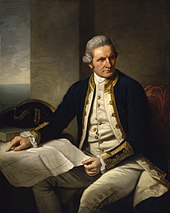
Westerners also expanded in Asia. The Portuguese controlled port cities in the East Indies, India, Persian Gulf, Sri Lanka, Southeast Asia and China. During this time, the Dutch began their colonisation of the Indonesian archipelago, which became the Dutch East Indies in the early 19th century, and gained port cities in Sri Lanka and Malaysia and India. Spain conquered the Philippines and converted the inhabitants to Catholicism. Missionaries from Iberia (including some from Italy and France) gained many converts in Japan until Christianity was outlawed by Japan's emperor. Some Chinese also became Christian, although most did not. Most of India was divided up between England and France.
As Western powers expanded they competed for land and resources. In the Caribbean,
The Dutch navigator Willem Janszoon had been the first documented Westerner to land in Australia in 1606[32][33][34] Another Dutchman, Abel Tasman later touched mainland Australia, and mapped Tasmania and New Zealand for the first time, in the 1640s. The English navigator James Cook became first to map the east coast of Australia in 1770. Cook's extraordinary seamanship greatly expanded European awareness of far shores and oceans: his first voyage reported favourably on the prospects of colonisation of Australia; his second voyage ventured almost to Antarctica (disproving long held European hopes of an undiscovered Great Southern Continent); and his third voyage explored the Pacific coasts of North America and Siberia and brought him to Hawaii, where an ill-advised return after a lengthy stay saw him clubbed to death by natives.[35]
Europe's period of expansion in early modern times greatly changed the world. New crops from the Americas improved European diets. This, combined with an improved economy thanks to Europe's new network of colonies, led to a demographic revolution in the West, with infant mortality dropping, and Europeans getting married younger and having more children. The West became more sophisticated economically, adopting Mercantilism, in which companies were state-owned and colonies existed for the good of the mother country.
Enlightenment
Absolutism and the Enlightenment: 1500–1800

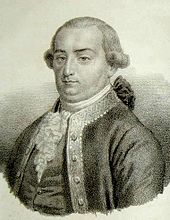

The West in the early modern era went through great changes as the traditional balance between monarchy, nobility and clergy shifted. With the feudal system all but gone, nobles lost their traditional source of power. Meanwhile, in Protestant countries, the church was now often headed by a monarch, while in Catholic countries, conflicts between monarchs and the Church rarely occurred and monarchs were able to wield greater power than they ever had in Western history.[citation needed] Under the doctrine of the Divine right of kings, monarchs believed they were only answerable to God: thus giving rise to absolutism.
At the opening of the 15th century, tensions were still going on between Islam and Christianity. Europe, dominated by Christians, remained under threat from the Muslim
The 16th century is often called Spain's
After Spain began to decline in the 17th century, the Dutch, by virtue of its sailing ships, became the greatest world power, leading the 17th century to be called the

The
One land where absolutism did not take hold was England, which had trouble with revolutionaries.

The
The intellectual movement called the Age of Enlightenment began in this period as well. Its proponents opposed the absolute rule of the monarchs, and instead emphasized the equality of all individuals and the idea that governments should derive their existence from the consent of the governed. Enlightenment thinkers called philosophes (French for philosophers) idealized Europe's classical heritage. They looked at Athenian democracy and the Roman Republic as ideal governments. They believed reason held the key to creating an ideal society. [citation needed]

The Englishman Francis Bacon espoused the idea that senses should be the primary means of knowing, while the Frenchman René Descartes advocated using reason over the senses. In his works, Descartes was concerned with using reason to prove his own existence and the existence of the external world, including God. Another belief system became popular among philosophes, Deism, which taught that a single god had created but did not interfere with the world. This belief system never gained popular support and largely died out by the early 19th century.
In 1690 John Locke wrote that people have certain
The Scottish Enlightenment was a period in 18th century Scotland characterised by an outpouring of intellectual and scientific accomplishments. Scotland reaped the benefits of establishing Europe's first public education system and a growth in trade which followed the Act of Union with England of 1707 and expansion of the British Empire. Important modern attitudes towards the relationship between science and religion were developed by the philosopher/historian David Hume. Adam Smith developed and published The Wealth of Nations, the first work in modern economics. He believed competition and private enterprise could increase the common good. The celebrated bard Robert Burns is still widely regarded as the national poet of Scotland.
European cities like Paris, London, and Vienna grew into large metropolises in early modern times. France became the cultural center of the West. The middle class grew even more influential and wealthy. Great artists of this period included El Greco, Rembrandt, and Caravaggio.
By this time, many around the world wondered how the West had become so advanced, for example, the Orthodox Christian Russians, who came to power after conquering the Mongols that had conquered Kiev in the Middle Ages. They began westernizing under Czar Peter the Great, although Russia remained uniquely part of its own civilization. The Russians became involved in European politics, dividing up the Polish–Lithuanian Commonwealth with Prussia and Austria.
Revolution: 1770–1815
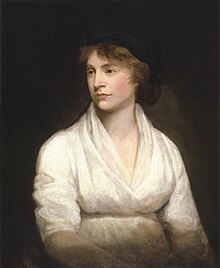
During the late 18th century and early 19th century, much of the West experienced a series of
After Britain's King
We hold these truths to be self-evident, that
Life, Liberty and the pursuit of Happiness. That to secure these rights, Governments are instituted among Men, deriving their just powers from the consent of the governed, That whenever any Form of Government becomes destructive of these ends, it is the Right of the People to alter or to abolish it, and to institute new Government.
The other major Western revolution at the turn of the 19th century was the
The people of Paris feared the King would try to stop the work of the National Assembly and Paris was soon consumed with riots, anarchy, and widespread looting. The mobs soon had the support of the French Guard, including arms and trained soldiers, because the royal leadership essentially abandoned the city. On the fourteenth of July 1789 a mob stormed the Bastille, a prison fortress, which led the King to accept the changes. On 4 August 1789 the National Constituent Assembly abolished feudalism sweeping away both the seigneurial rights of the Second Estate and the tithes gathered by the First Estate. It was the first time in Europe, where feudalism was the norm for centuries, that such a thing happened. In the course of a few hours, nobles, clergy, towns, provinces, companies, and cities lost their special privileges.
At first, the revolution seemed to be turning France into a
Liberté, égalité, fraternité (French for "Liberty, equality, fraternity"),[40] now the national motto of France, had its origins during the French Revolution, though it was only later institutionalised. It remains another iconic motto of the aspirations of Western governance in the modern world.
Some influential intellectuals came to reject the excesses of the revolutionary movement. Political theorist
Napoleonic Wars

The
France had to fight on multiple battlefronts against the other European powers. A nationwide conscription was voted to reinforce the old royal army made of noble officers and professional soldiers. With this new kind of army, Napoleon was able to beat the European allies and dominate Europe. The revolutionary ideals, based no more on feudalism but on the concept of a sovereign nation, spread all over Europe. When Napoleon eventually lost and the monarchy reinstated in France these ideals survived and led to the revolutionary waves of the 19th century that brought democracy to many European countries.[citation needed]
With the success of the American Revolution, the
Rise of the English-speaking world: 1815–1870

The years following Britain's victory in the Napoleonic Wars were a period of expansion for Britain as it rebuilt the British Empire. The new United States grew even more rapidly. This period of expansion would help establish Anglicanism as the dominant religion, English as the dominant language, and English and Anglo-American culture as the dominant culture of two continents and many other lands outside the British Isles.
Industrial Revolution in the English-speaking world

Rapid economic growth following the Napoleonic Wars was the continuing product of the ever-expanding
New ideological movements began as a result of the Industrial Revolution, including the
Great Britain: 1815–1870

From 1837 until 1901,
Ireland had been ruled from London since the Middle Ages. After the Protestant Reformation the British Establishment began a campaign of discrimination against Roman Catholic and
British Empire: 1815–1870
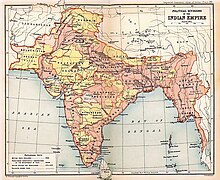
Throughout the 19th century, Britain's power grew enormously and the sun quite literally "never set" on the British Empire, for it had outposts on every occupied continent. It consolidated control over such far flung territories as Canada and Jamaica in the Americas, Australia and New Zealand in Oceania; Malaya, Hong Kong and Singapore in the Far East and a line of colonial possessions from Egypt to the Cape of Good Hope through Africa. All of India was under British rule by 1870.
In 1804, the Shah of the declining
In the Far East, Britain went to war with the declining Qing dynasty of China when it tried to stop British merchants in China from selling the opium to the Chinese public. The First Opium War (1840–1842), ended in a British victory, and China was forced to remove barriers to British trade and cede several ports and the island of Hong Kong to Britain. Soon, other powers sought these same privileges with China and China was forced to agree, ending Chinese isolation from the rest of the world. In 1853 an American expedition opened up Japan to trade with first the U.S., and then the rest of the world.
In 1833 Britain ended slavery by buying out all the owners throughout its empire after a successful campaign by abolitionists. Furthermore, Britain had a great deal of success attempting to get other powers to outlaw the practice as well.
As British settlement of southern Africa continued, the descendants of the Dutch in southern Africa, called the Boers or Afrikaners, whom Britain had ruled since the Anglo-Dutch Wars, migrated northward, disliking British rule. Explorers and missionaries like David Livingstone became national heroes. Cecil Rhodes founded Rhodesia and a British army under Lord Kitchener secured control of Sudan in the 1898 Battle of Omdurman.
Canada: 1815–1870

Following the American Revolution, many Loyalists to Britain fled north to what is today Canada (where they were called United Empire Loyalists). Joined by mostly British colonists, they helped establish early colonies like Ontario and New Brunswick. British settlement in North America increased, and soon there were several colonies both north and west of the early ones in the northeast of the continent, these new ones included British Columbia and Prince Edward Island. Rebellions broke out against British rule in 1837, but Britain appeased the rebels' supporters in 1867 by confederating the colonies into Canada, with its own prime minister. Although Canada was still firmly within the British Empire, its people now enjoyed a great degree of self-rule. Canada was unique in the British Empire in that it had a French-speaking province, Quebec, which Britain had gained rule over in the Seven Years' War.
Australia and New Zealand: 1815–1870

The
The native inhabitants of Australia, called the
From the early 19th century, New Zealand was being visited by European explorers, sailors, missionaries, traders and adventurers (known as Pākehā) and was administered by Britain from the nearby colony of New South Wales. In 1840 Britain signed the Treaty of Waitangi with the natives of New Zealand, the Māori, in which Britain gained sovereignty over the archipelago. As more European settlers arrived, clashes resulted and the New Zealand colonial government fought several wars before defeating the Māori. By 1870, New Zealand had a population made up mostly of European descent.[46]
United States: 1815–1870
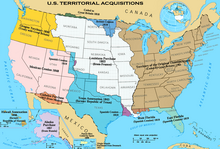

Following independence from Britain, the United States began expanding westward, and soon a number of new states had joined the union. In 1803, the United States purchased the
Politically, the U.S. became more democratic with the abolishment of property requirements in voting, although voting remained restricted to white males. By the mid-19th century, the most important issue was slavery. The
The
[We here] highly resolve that these dead shall not have
died in vain;that this nation, under God, shall have a new birth of freedom; and that government of the people, by the people, for the people, shall not perish from the earth.
Continental Europe: 1815–1870
The years following the Napoleonic Wars were a time of change in Europe. The Industrial Revolution, nationalism, and several political revolutions transformed the continent.
Industrial technology was imported from Britain. The first lands affected by this were France, the Low Countries, and western Germany. Eventually the Industrial Revolution spread to other parts of Europe. Many people in the countryside migrated to major cities like Paris, Berlin, and Amsterdam, which were connected like never before by railroads. Europe soon had its own class of wealthy industrialists, and large numbers of industrial workers. New ideologies emerged as a reaction against perceived abuses of industrial society. Among these ideologies were socialism and the more radical communism, created by the German Karl Marx. According to communism, history was a series of class struggles, and at the time industrial workers were pitted against their employers. Inevitably the workers would rise up in a worldwide revolution and abolish private property, according to Marx. Communism was also atheistic, since, according to Marx, religion was simply a tool used by the dominant class to keep the oppressed class docile.
Several revolutions occurred in Europe following the Napoleonic Wars. The goal of most of these revolutions was to establish some form of democracy in a particular nation. Many were successful for a time, but their effects were often eventually reversed. Examples of this occurred in Spain, Italy, and Austria. Several European nations stood steadfastly against revolution and democracy, including Austria and Russia. Two successful revolts of the era were the Greek and
In the
Prussia in the middle and late parts of the 19th century was ruled by its king,
After years of dealing with Hungarian revolutionaries, whose kingdom Austria had conquered centuries earlier, the Austrian emperor,
There were changes throughout the West in science, religion and culture between 1815 and 1870. Europe in 1870 differed greatly from its state in 1815. Most Western European nations had some degree of democracy, and two new national states had been created, Italy and Germany. Political parties were formed throughout the continent and with the spread of industrialism, Europe's economy was transformed, although it remained very agricultural.
Culture, arts and sciences: 1815–1914
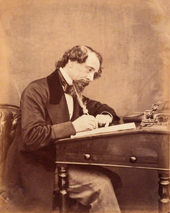

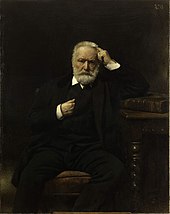

The 19th and early 20th centuries saw important contributions to the process of modernisation of
Napoleon re-established the Catholic Church in France through the
The 1859 publication of
In Europe by the 19th century, fashion had shifted away from such artistic styles as
Just as Mannerism rejected Classicism, so did
Some of the best regarded poets of the era were women.
In early 19th-century Europe, in response to
Writers also sought to come to terms with the new industrial age. The works of the Englishman
The response of architecture to industrialisation, in stark contrast to the other arts, was to veer towards historicism. The railway stations built during this period are often called "the cathedrals of the age". Architecture during the Industrial Age witnessed revivals of styles from the distant past, such as the
Out of the naturalist ethic of Realism grew a major artistic movement, Impressionism. The Impressionists pioneered the use of light in painting as they attempted to capture light as seen from the human eye. Edgar Degas, Édouard Manet, Claude Monet, Camille Pissarro, and Pierre-Auguste Renoir, were all involved in the Impressionist movement. As a direct outgrowth of Impressionism came the development of Post-Impressionism. Paul Cézanne, Vincent van Gogh, Paul Gauguin, Georges Seurat are the best known Post-Impressionists. In Australia the Heidelberg School was expressing the light and colour of Australian landscape with a new insight and vigour.
The
New Imperialism: 1870–1914
The years between 1870 and 1914 saw the expansion of Western power. By 1914, the Western and some Asian and Eurasian empires like the
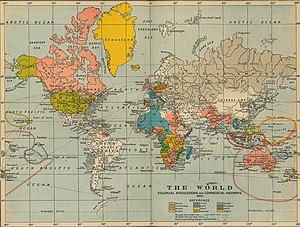
Although the West had had a presence in Africa for centuries, its colonies were limited mostly to Africa's coast. Europeans, including the Britons
In Asia, China was defeated by Britain in the First Opium War and later Britain and France in the
The Pacific islands were conquered by Germany, the U.S., Britain, France, and Belgium. In 1893, the ruling class of colonists in Hawaii overthrew the Hawaiian monarchy of
Latin America was largely free from foreign rule throughout this period, although the United States and Britain had a great deal of influence over the region. Britain had two colonies on the Latin American mainland, while the United States, following 1898, had several in the Caribbean. The U.S. supported the independence of Cuba and Panama, but gained a small territory in central Panama and intervened in Cuba several times. Other countries also faced American interventions from time to time, mostly in the Caribbean and southern North America.
Competition over control of overseas colonies sometimes led to war between Western powers, and between Western powers and non-Westerners. At the turn of the 20th century, Britain fought several wars with Afghanistan to prevent it from falling under the influence of Russia, which ruled all of Central Asia excluding Afghanistan. Britain and France nearly went to war over control of Africa. In 1898, the United States and Spain went to war after an American naval ship was sunk in the Caribbean. Although today it is generally held that the sinking was an accident, at the time the U.S. held Spain responsible and soon American and Spanish forces clashed everywhere from Cuba to the Philippines. The U.S. won the war and gained several Caribbean colonies including Puerto Rico and several Pacific islands, including Guam and the Philippines. Important resistance movements to Western Imperialism included the Boxer Rebellion, fought against the colonial powers in China, and the Philippine–American War, fought against the United States, both of which failed.
The
The expanding Western powers greatly changed the societies they conquered. Many connected their empires via railroad and telegraph and constructed churches, schools, and factories.
Great powers and the First World War: 1870–1918

By the late 19th century, the world was dominated by a few
Western inventors and industrialists transformed the West in the late 19th century and early 20th century. The American
Culturally, the English-speaking nations were in the midst of the Victorian era, named for Britain's queen. In France, this period is called the Belle Époque, a period of many artistic and cultural achievements. The suffragette movement began in this period, which sought to gain voting rights for women, with New Zealand and Australian parliaments granting women's suffrage in the 1890s. However, by 1914, only a dozen U.S. states had given women this right, although women were treated more and more as equals of men before the law in many countries.
Cities grew as never before between 1870 and 1914. This led at first to unsanitary and crowded living conditions, especially for the poor. However, by 1914, municipal governments were providing police and fire departments and garbage removal services to their citizens, leading to a drop in death rates. Unfortunately, pollution from burning coal and wastes left by thousands of horses that crowded the streets worsened the quality of life in many urban areas. Paris, lit up by gas and electric light, and containing the tallest structure in the world at the time, the Eiffel Tower, was often looked to as an ideal modern city, and served as a model for city planners around the world.
United States: 1870–1914
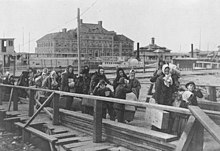
Following the
Another great change beginning in the 1870s was the settlement of the western territories by Americans. The population growth in the
America's population greatly increased between 1870 and 1914, due largely to immigration. The U.S. had been receiving immigrants for decades but at the turn of the 20th century, the numbers greatly increased due partly to large population growth in Europe. Immigrants often faced discrimination, because many differed from most Americans in religion and culture. Despite this, most immigrants found work and enjoyed a greater degree of freedom than in their home countries. Major immigrant groups included the Irish, Italians, Russians, Scandinavians, Germans, Poles and
The U.S. became a major military and industrial power during this time, gaining a colonial empire from Spain and surpassing Britain and Germany to become the world's major industrial power by 1900. Despite this, most Americans were reluctant to get involved in world affairs, and American presidents generally tried to keep the U.S. out of foreign entanglement.
Europe: 1870–1914
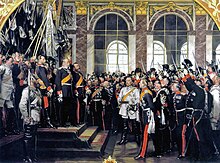
The years between 1870 and 1914 saw the rise of Germany as the dominant power in Europe. By the late 19th century, Germany had surpassed Britain to become the world's greatest industrial power. It also had the mightiest army in Europe.[citation needed] From 1870 to 1871, Prussia was at war with France. Prussia won the war and gained two border territories, Alsace and Lorraine, from France. After the war, Wilhelm took the title kaiser from the Roman title caesar, proclaimed the German Empire, and all the German states other than Austria united with this new nation, under the leadership of Prussian Chancellor Otto von Bismarck.
After the Franco-Prussian War, Napoleon III was dethroned and France was proclaimed a republic. During this time, France was increasingly divided between Catholics and monarchists and anticlerical and republican forces. In 1900, church and state were officially separated in France, although the majority of the population remained Catholic. France also found itself weakened industrially following its war with Prussia due to its loss of iron and coal mines following the war. In addition, France's population was smaller than Germany's and was hardly growing. Despite all this, France's strong sense of nationhood, among other things, kept the country together.
Between 1870 and 1914, Britain continued to peacefully switch between Liberal and Conservative governments, and maintained its vast empire, the largest in world history. Two problems faced by Britain in this period were the resentment of British rule in Ireland and Britain's falling behind Germany and the United States in industrial production.
British dominions: 1870–1914
The European populations of Canada, Australia, New Zealand and South Africa all continued to grow and thrive in this period and evolved democratic Westminster system parliaments.
Canada united as a
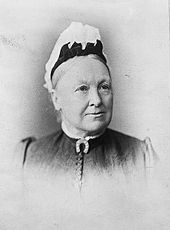
From the 1850s, Canada, Australia and New Zealand had become laboratories of democracy. By the 1870s, they had already granted voting rights to their citizens in advance of most other Western nations. In 1893, New Zealand became the first self-governing nation to extend the right to vote to women and, in 1895, the women of South Australia also became the first to obtain the right to stand for Parliament.
During the 1890s Australia also saw such milestones as the invention of the
From the 1880s, the
Rival alliances

The late 19th century saw the creation of two rival alliances in Europe. Germany, Italy, and Austria-Hungary formed the
World War I
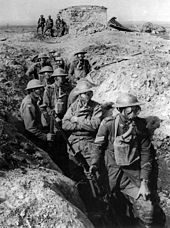
When the war broke out, much of the fighting was between Western powers, and the immediate
1916 saw some of the most ferocious fighting in human history with the
1917 was a crucial year in the war. The United States had followed a policy of neutrality in the war, feeling it was a European conflict. However, during the course of the war many Americans had died on board British ocean liners sunk by the Germans, leading to anti-German feelings in the U.S. There had also been incidents of sabotage on American soil, including the Black Tom explosion. What finally led to American involvement in the war, however, was the discovery of the Zimmermann Telegram, in which Germany offered to help Mexico conquer part of the United States if it formed an alliance with Germany. In April, the U.S. declared war on Germany. The same year the U.S. entered the war, Russia withdrew. After the deaths of many Russian soldiers and hunger in Russia, a revolution occurred against the Czar, Nicholas II. Nicholas abdicated and a Liberal provisional government was set up. In October, Russian communists, led by Vladimir Lenin rose up against the government, resulting in a civil war. Eventually, the communists won and Lenin became premier. Feeling World War I was a capitalist conflict, Lenin signed a peace treaty with Germany in which it gave up a great deal of its Central and Eastern European lands.
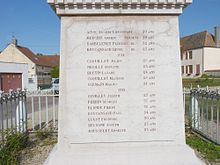
Although Germany and its allies no longer had to focus on Russia, the large numbers of American troops and weapons reaching Europe turned the tide against Germany, and after more than a year of fighting, Germany surrendered.
The treaties which ended the war, including the famous
In the Middle East, Britain gained Palestine, Transjordan (modern-day Jordan), and Mesopotamia as colonies. France gained Syria and Lebanon. An independent kingdom consisting of most of the Arabian peninsula, Saudi Arabia, was also established. Germany's colonies in Africa, Asia, and the Pacific were divided between the British and French Empires.
The war had cost millions of lives and led many in the West to develop a strong distaste for war. Few were satisfied with, and many despised the agreements made at the end of the war. Japanese and Italians were angry that they had not been given any new colonies after the war, and many Americans felt the war had been a mistake. Germans were outraged at the state of their country following the war. Also, unlike many in the United States had hoped for, democracy did not flourish in the world in the post-war period.
Interwar years: 1918–1939
United States in the interwar years
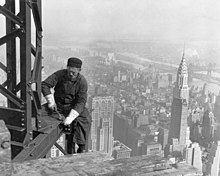
After World War I, most Americans regretted getting involved in world affairs and desired a "return to normalcy". The 1920s were a period of economic prosperity in the United States. Many Americans bought cars, radios, and other appliances with the help of installment payments. Also, many Americans invested in the stock market as a source of income. Movie theaters sprang up throughout the country, although at first they did not have sound. Alcoholic beverages were outlawed in the United States and women were granted the right to vote. Although the United States was arguably the most powerful nation in the post-war period, Americans remained isolationist and elected several conservative presidents during this period.
In October 1929 the
Europe in the interwar years
Europe was relatively unstable following World War I. Although many prospered in the 1920s, Germany was in a deep financial and economic crisis. Also, France and Britain owed the U.S. a great deal of money. When the United States went into Depression, so did Europe. There were perhaps 30 million people around the world unemployed following the Depression. Many governments helped to alleviate the suffering of their citizens and by 1937 the economy had improved although the lingering effects of the Depression remained. Also, the Depression led to the spread of radical left-wing and right-wing ideologies, like Communism and Fascism.
In 1919-1921
In 1916, militant Irish republicans staged a
In the 1920s, the UK granted the right to vote to women.
British dominions in the interwar years
The relationship between Britain and its Empire evolved significantly over the period. In 1919, the British Empire was represented at the all-important
Rise of totalitarianism
The Inter-war years saw the establishment of the first

The first totalitarian state in the West was established in Italy. Unlike the Soviet Union however, this would be a Fascist rather than a Communist state.
Another Fascist party, the Nazis, would take power in Germany. The Nazis were similar to Mussolini's Fascists but held many views of their own. Nazis were obsessed with racial theory, believing Germans to be part of a master race, destined to dominate the inferior races of the world. The Nazis were especially hateful of Jews. Another unique aspect of Nazism was its connection with a small movement that supported a return to ancient Germanic paganism. Adolf Hitler, a World War I veteran, became leader of the party in 1921. Gaining support from many disillusioned Germans, and by using intimidation against its enemies, the Nazi party had gained a great deal of power by the early 1930s. In 1933, Hitler was named Chancellor, and seized dictatorial power. Hitler built up Germany's military in violation of the Versailles Treaty and stripped Jews of all rights in Germany. Eventually, the regime Hitler created would lead to the Second World War.
In Spain, a Republic was proclaimed in 1931 in the wake of the demise of the Bourbon monarchic regime and its dictatorial solution. In 1936, a military coup d'état against the republic started the Spanish Civil War, which ended in 1939 with the victory of the rebel side (supported by Fascist Italy and Nazi Germany) and with Francisco Franco as dictator.
Second World War and its aftermath: 1939–1950
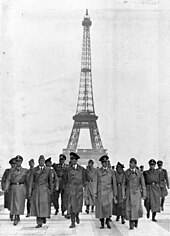
The late 1930s saw a series of violations of the Versailles Treaty by Germany, however, France and Britain refused to act. In 1938, Hitler annexed Austria in an attempt to unite all German-speakers under his rule. Next, he annexed a German-speaking area of Czechoslovakia. Britain and France agreed to recognize his rule over that land and in exchange Hitler agreed not to expand his empire further. In a matter of months, however, Hitler broke the pledge and annexed the rest of Czechoslovakia. Despite this, the British and French chose to do nothing, wanting to avoid war at any cost. Hitler then formed a secret non-aggression pact with the Soviet Union, despite the fact that the Soviet Union was Communist and Germany was Nazi. Also in the 1930s, Italy conquered Ethiopia. The Soviets too began annexing neighboring countries. Japan began taking aggressive actions towards China. After Japan opened itself to trade with the West in the mid-19th century, its leaders learned to take advantage of Western technology and industrialized their country by the end of the century. By the 1930s, Japan's government was under the control of militarists who wanted to establish an empire in the Asia-Pacific region. In 1937, Japan invaded China.
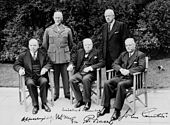
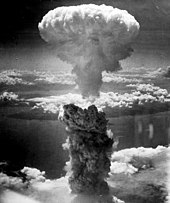
In 1939, German forces invaded Poland, and soon the country was divided between the Soviet Union and Germany. France and Britain declared war on Germany,
The United States attempted to remain neutral early in the war. However, a growing number feared the consequences of a Fascist victory. President Roosevelt began sending weapons and support to the British, Chinese, and Soviets. Also, the U.S. placed an embargo against the Japanese, as they continued their war with China and conquered many colonies formerly ruled by the French and Dutch, who were now under German rule. In 1941, Japan launched a surprise
In the
By 1942, German and Italian armies ruled Norway, the Low Countries, France, the Balkans, Central Europe, part of Russia, and most of North Africa. Japan by this year ruled much of China, Southeast Asia, Indonesia, the Philippines, and many Pacific Islands. Life in these empires was cruel – especially in Germany, where the Holocaust was perpetrated. Eleven million people – six million of them Jews – were systematically murdered by the German Nazis by 1945.
From 1943 on, the Allies gained the upper hand. American and British troops first liberated North Africa from the Germans and Italians. Next they invaded Italy, where Mussolini was deposed by the king and later was killed by Italian partisans. Italy surrendered and came under Allied occupation. After the liberation of Italy, American, British, and Canadian troops
After the war the U.S., Britain and the Soviet Union attempted to cooperate. German and Japanese military leaders responsible for atrocities in their regimes were put on trial and many were executed. The international organization the United Nations was created. Its goal was to prevent wars from breaking out as well as provide the people of the world with security, justice and rights. The period of post-war cooperation ended, however, when the Soviet Union rigged elections in the occupied nations of Central and Eastern Europe to allow for Communist victories. Soon, all of Eastern and much of Central Europe had become a series of Communist dictatorships, all staunchly allied with the Soviet Union. Germany following the war had been occupied by British, American, French, and Soviet forces. Unable to agree on a new government, the country was divided into a democratic west and Communist east. Berlin itself was also divided, with West Berlin becoming part of West Germany and East Berlin becoming part of East Germany. Meanwhile, the former Axis nations soon had their sovereignty restored, with Italy and Japan regaining independence following the war.
World War II had cost millions of lives and devastated many others. Entire cities lay in ruins and economies were in shambles. However, in the Allied countries, the people were filled with pride at having stopped Fascism from dominating the globe, and after the war, Fascism was all but extinct as an ideology. The world's balance of power also shifted, with the United States and Soviet Union being the world's two superpowers.
Fall of the Western empires: 1945–1999

Following World War II, the great colonial empires established by the Western powers beginning in early modern times began to collapse. There were several reasons for this. Firstly, World War II had devastated European economies and had forced governments to spend great deals of money, making the price of colonial administration increasingly hard to manage. Secondly, the two new superpowers following the war, the United States and Soviet Union were both opposed to imperialism, so the now weakened European empires could generally not look to the outside for help.[citation needed] Thirdly, Westerners increasingly were not interested in maintaining and even opposed the existence of empires.[citation needed] The fourth reason was the rise of independence movements following the war. The future leaders of these movements had often been educated at colonial schools run by Westerners where they adopted Western ideas like freedom, equality, self-determination and nationalism, and which turned them against their colonial rulers.[citation needed]
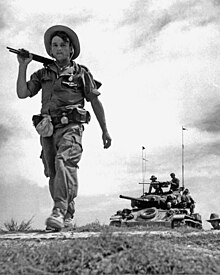
The first colonies to gain independence were in Asia. In 1946, the U.S. granted independence to the
In the Middle East, following World War II, Britain had granted independence to the formerly Ottoman territories of Mesopotamia, which became
The other major center of colonial power, Africa, was freed from colonial rule following World War II as well. Egypt gained independence from Britain and this was soon followed by Ghana and Tunisia. One violent independence movement of the time was fought in Algeria, in which Algerian rebels went so far as to kill innocent Frenchmen. In 1962, however, Algeria gained independence from France. By the 1970s the entire continent had become independent of European rule, although a few southern countries remained under the rule of white colonial minorities.
By the close of the 20th century, the European colonial Empires had ceased to exist as significant global entities. Sunset for the
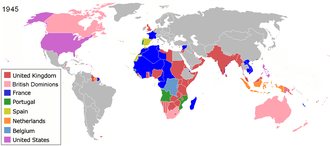
Of Europe's empires, only the Russian Empire remained a significant geo-political force into the late 20th century, having morphed into the Soviet Union and Warsaw Pact, which, drawing on the writings of the German Karl Marx, established a socialist economic model under Communist dictatorship, which ultimately collapsed in the early 1990s. Adaptations of Marxism continued as the stated inspiration for Governments in Central America and Asia into the 21st century – though only a handful survived the end of the Cold War.
The end of the Western Empires greatly changed the world. Although many newly independent nations attempted to become democracies, many slipped into military and autocratic rule. Amid power vacuums and newly determined national borders, civil war also became a problem, especially in Africa, where the introduction of firearms to ancient tribal rivalries exacerbated problems.
The loss of overseas colonies partly also led many Western nations, particularly in continental Europe, to focus more on European, rather than global, politics as the European Union rose as an important entity. Though gone, the colonial empires left a formidable cultural and political legacy, with English, French, Spanish, Portuguese, Russian and Dutch being spoken by peoples across far flung corners of the globe. European technologies were now global technologies – religions like Catholicism and Anglicanism, founded in the West, were booming in post colonial Africa and Asia. Parliamentary (or presidential) democracies, as well as rival Communist style one party states invented in the West had replaced traditional monarchies and tribal government models across the globe. Modernity, for many, was equated with Westernisation.
Cold War: 1945–1991
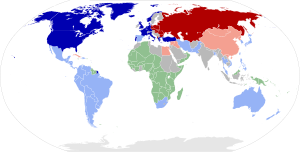
From the end of World War II almost until the start of the 21st century, Western and world politics were dominated by the state of tensions and conflict between the world's two
Rather than revert to isolationism, the United States took an active role in global politics following World War II to halt Communist expansion. After the war, Communist parties in Western Europe increased in prestige and number, especially in Italy and France, leading many to fear the whole of Europe would become Communist. The U.S. responded to this with the
One of the first actual conflicts of the Cold War took place in China. Following the withdrawal of Japanese troops after World War II, China was plunged into
The world lived in the constant fear of World War III in the Cold War. Seemingly any conflict involving Communism might lead to a conflict between the Warsaw pact countries and the NATO countries. The prospect of a third world war was made even more frightening by the fact that it would almost certainly be a nuclear war. In 1949 the Soviets developed their first atomic bomb, and soon both the United States and Soviet Union had enough to destroy the world several times over. With the development of missile technology, the stakes were raised as either country could launch weapons from great distances across the globe to their targets. Eventually, Britain, France, and China would also develop nuclear weapons. It is believed that Israel developed nuclear weapons as well.
One major event that nearly brought the world to the brink of war was the Cuban Missile Crisis. In the 1950s a revolution in Cuba had brought the only Communist regime in the Western Hemisphere to power. In 1962, the Soviets began constructing missile sites in Cuba and sending nuclear missiles. Because of its close proximity to the U.S., the U.S. demanded the Soviets withdraw missiles from Cuba. The U.S. and Soviet Union came very close to attacking one another, but in the end came to a secret agreement in which the NATO withdrew missiles in exchange for a Soviet withdrawal of missiles from Cuba.
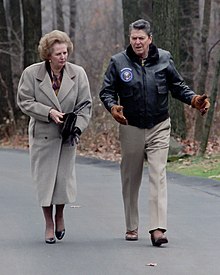
The next great Cold War conflict occurred in Southeast Asia. In the 1960s, North Vietnam invaded South Vietnam, hoping to unite all of Vietnam under Communist rule. The U.S. responded by supporting the South Vietnamese. In 1964, American troops were sent to "save" South Vietnam from conquest, which many Americans feared would lead to Communist dominance in the entire region. The Vietnam War lasted many years, but most Americans felt the North Vietnamese would be defeated in time. Despite American technological and military superiority, by 1968, the war showed no signs of ending and most Americans wanted U.S. forces to end their involvement. The U.S. undercut support for the North by getting the Soviets and Chinese to stop supporting North Vietnam, in exchange for recognition of the legitimacy of mainland China's Communist government, and began withdrawing troops from Vietnam. In 1972, the last American troops left Vietnam and in 1975 South Vietnam fell to the North. In the following years Communism took power in neighboring Laos and Cambodia.
By the 1970s global politics were becoming more complex. For example, France's president proclaimed France was a great power in and of itself. However, France did not seriously threaten the U.S. for supremacy in the world or even Western Europe. In the Communist world, there was also division, with the Soviets and Chinese differing over how Communist societies should be run. Soviet and Chinese troops even engaged in border skirmishes, although full-scale war never occurred.
The last great armed conflict of the Cold War took place in

The late 1970s had seen a lessening of tensions between the U.S. and Soviet Union, called
Following the end of the Cold War, Communism largely died out as a major political movement. After the fall of USSR, the United States became the world's only superpower.
Western countries: 1945–1980
United States: 1945–1980
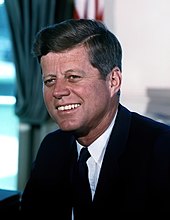
Following World War II, there was an unprecedented period of prosperity in the United States. The majority of Americans entered the middle class and moved from the cities into surrounding suburbs, buying homes of their own. Most American households owned at least one car, as well as the relatively new invention, the television. Also, the American population greatly increased as part of the so-called "baby boom" following the war. For the first time following the war, large of numbers of non-wealthy Americans were able to attend college.
Following the war, black Americans started what has become known as the
In politics, the Democratic and Republican parties remained dominant. In 1945, the Democratic party relied on Southerners, whose support went back to the days when Democrats defended a state's right to own slaves, and Northeasterners and industrial Mid-Westerners, who supported the pro-labor and pro-immigrant policies of the Democrats. Republicans tended to rely on middle-class Protestants from elsewhere in the country. As the Democrats began championing civil rights, however, Southern Democrats felt betrayed, began voting Republican. Presidents from this period were
. The years 1945–1980 saw the expansion of federal power and the establishment of programs to help the elderly and poor pay for medical expenses.By 1980, many Americans had become pessimistic about their country. Despite its status as one of only two superpowers, the Vietnam War as well as the social upheavals of the 1960s and an economic downturn in the 1970s led America to become a much-less confident nation.
Europe
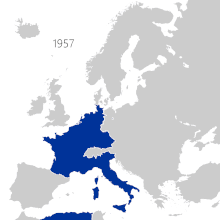
At the close of the war, much of Europe lay in ruins with millions of homeless refugees. A souring of relations between the Western Allies and the Soviet Union then saw Europe split by an Iron Curtain, dividing the continent between West and East. In Western Europe, democracy had survived the challenge of Fascism and began a period of intense rivalry with Eastern Communism, which was to continue into the 1980s. France and Britain secured themselves permanent positions on the newly formed United Nations Security Council, but Western European empires did not long survive the war, and no one Western European nation would ever again be the paramount power in world affairs.[61]
Despite these immense challenges however, Western Europe again rose as an economic and cultural powerhouse. Assisted first by the
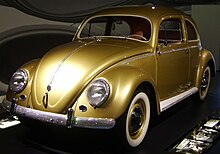
Facing a new power balance between the Soviet East and American West, Western European nations moved closer together. In 1957, Belgium, France, the Netherlands, West Germany, Italy and Luxembourg signed the landmark Treaty of Rome, creating the European Economic Community, free of customs duties and tariffs, and allowing the rise of a new European geo-political force.[61] Eventually, this organization was renamed the European Union or (EU), and many other nations joined, including Britain, Ireland, and Denmark. The EU worked toward economic and political cooperation among European nations.
Between 1945 and 1980, Europe became increasingly socialist.[
Europe had many important political leaders during this time. Charles de Gaulle, leader of the French government in exile during World War II, served as France's president for many years. He sought to carve out for France a great power status in the world.
Although Europe as a whole was relatively peaceful in this period, both Britain and Spain suffered from acts of terrorism. In Britain,
For Greece, Spain and Portugal, ideological battles between left and right continued and the emergence of parliamentary democracy was troubled. Greece experienced
British Empire and Commonwealth 1945–1980
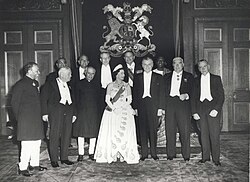
Between 1945 and 1980, the British Empire was transformed from its centuries old position as a global colonial power, to a voluntary association known as the Commonwealth of Nations – only some of which retained any formal political links to Britain or its monarchy. Some former British colonies or protectorates disassociated themselves entirely from Britain.
Britain
The popular war time leader Winston Churchill was swept from office at the 1945 election and the Labour Government of Clement Attlee introduced a program of nationalisation of industry and introduced wide-ranging social welfare. Britain's finances had been ravaged by the war and John Maynard Keynes was sent to Washington to negotiate the massive Anglo-American loan on which Britain relied to fund its post-war reconstruction.[62]
India was granted Independence in 1947 and Britain's global influence rapidly declined as decolonisation proceeded. Though the USSR and United States now stood as the post war super powers, Britain and France launched the ill-fated Suez intervention in the 1950s, and Britain committed to the Korean War.
From the 1960s The Troubles afflicted Northern Ireland, as British Unionist and Irish Republican paramilitaries conducted campaigns of violence in support of their political goals. The conflict at times spilled into Ireland and England and continental Europe. Paramilitaries such as the IRA (Irish Republican Army) wanted union with the Republic of Ireland while the UDA (Ulster Defence Association) were supporters of Northern Ireland remaining within the United Kingdom.
In 1973, Britain entered the
Canada
Canada continued to evolve its own national identity in the post-war period. Although it was an independent nation, it remained part of the British Commonwealth and recognized the British monarch as the Canadian monarch as well. Following the war, French and English were recognized as co-equal official languages in Canada, and French became the only official language in the French-speaking province of Quebec. Referendums were held in both 1980 and 1995 in which Quebecers, however, voted not to secede from the union. Other cultural changes Canada faced were similar to those in the United States. Racism and discrimination largely disappeared in the post-war years, and dual-income families became the norm. Also, there was a rejection of traditional Western values by many in Canada. The government also established universal health care for its citizens following the war.
Australia and New Zealand: 1945–1980

Following World War II, Australia and New Zealand enjoyed a great deal of prosperity along with the rest of the West. Both countries remained
The arts also diversified and flourished over the period – with
Western culture: 1945–1980

The West went through a series of great cultural and social changes between 1945 and 1980. Mass media created a global culture that could ignore national frontiers. Literacy became almost universal, encouraging the growth of books, magazines and newspapers. The influence of cinema and radio remained, while televisions became near essentials in every home. A new pop culture also emerged with rock n roll and pop stars at its heart.
Religious observance declined in most of the West. Protestant churches began focusing more on
With the abolition of laws treating most non-whites as second-class citizens, overt institutional racism largely disappeared from the West. Although the United States failed to secure the legal equality of women with men (by the failure of Congress to ratify the Equal Rights Amendment), women continued working outside the home, and by 1980 the double-income family became commonplace in Western society. Beginning in the 1960s, many began rejecting traditional Western values and there was a decline in emphasis on church and the family.
Rock and roll emerged from the United States from the 1950s to become a quintessential 20th-century art form. Artists such as
Western nations: 1980–present
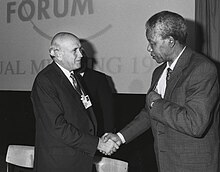
The 1980s were a period of economic growth in the West, though the
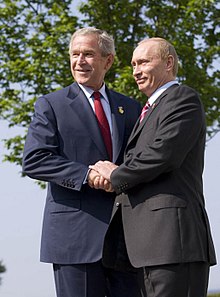

In the early stages after the Cold War, Russian president
Elsewhere, both within and without the West, democracy and capitalism were in the ascendant – even Communist holdouts like mainland China and (to a lesser extent) Cuba and Vietnam, while retaining one party government, experimented with market liberalisation, a process which accelerated after the fall of European Communism, enabling the re-emergence of China as an alternative centre of economic and political power standing outside the West.
Free trade agreements were signed by many countries. The European nations broke down trade barriers with one another in the EU, and the United States, Canada, and Mexico signed the
European countries have had very good relations with each other since 1980. The European Union has become increasingly powerful, taking on roles traditionally reserved for the nation-state. Although real power still exists in the individual member states, one major achievement of the Union was the introduction of the Euro, a currency adopted by most EU countries.
Australia and New Zealand continued their large multi-ethnic immigration programs and became more integrated in the Asia Pacific region. While remaining
Today Canada remains part of the Commonwealth, and relations between French and English Canada have continued to present problems. A referendum was held in Quebec, however, in 1980, in which Quebecers voted to remain part of Canada.
In 1990, the white-minority government of the
Since 1991, the United States has been regarded as the world's only superpower.[74] Politically, the United States is dominated by the Republican and Democratic parties. Presidents of the United States between 1980 and 2006 have been Ronald Reagan, George H. W. Bush, Bill Clinton, and George W. Bush. Since 1980, Americans have become far more optimistic about their country than they were in the 1970s.[citation needed] Since the 1960s, a large number of immigrants have been coming into the U.S., mostly from Asia and Latin America, with the largest single group being Mexicans. Large numbers from those areas have also been coming illegally, and the solution to this problem has produced much debate in the U.S.
On 11 September 2001, the United States suffered the worst terrorist attack in its history. Four planes were hijacked by Islamic extremists and crashed into the World Trade Center, the Pentagon, and a field in Pennsylvania.
The
Evidence of the major demographic and social shifts which have taken place within Western society since World War II can be found with the elections of national level leaders: United States (
Western nations and the world
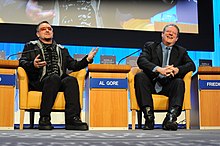
Following 1991, Western nations provided troops and aid to many war-torn areas of the world. Some of these missions were unsuccessful, like the attempt by the United States to provide relief in
The greatest war fought by the West in the 1990s, however, was the
The West had become increasingly unpopular in the Middle East following World War II. The Arab states greatly disliked the West's support for Israel. Many soon had a special hatred towards the United States, Israel's greatest ally. Also, partly to ensure stability on the region and a steady supply of the
In March 2011, a multi-state coalition led by
Western society and culture (since 1980)
In general, Western culture has become increasingly secular in Northern Europe, North America, Australia and New Zealand. Nevertheless, in a sign of the continuing status of the ancient Western institution of the
Historiography
Chicago historian
See also
- Outline of the history of Western civilization
- Role of Christianity in civilization
- History of Europe
- Eurocentrism
- Media
- Civilisation: A Personal View by Kenneth Clark (TV series), BBC TV, 1969
- The Ascent of Man (TV series), BBC TV, 1973
References
- ^ "Who Was Charlemagne and Why Is He Called the 'Father of Europe?'". History Hit. Retrieved 21 March 2022.
- )
- OCLC 48131970.
- OCLC 51943385.
- OCLC 787855578.
- ^ Roman Catholicism, "Roman Catholicism, Christian church that has been the decisive spiritual force in the history of Western civilization". Encyclopædia Britannica
- ^ Hayes, Carlton J.H. (1953). Christianity and Western Civilization, Stanford University Press, p. 2: That certain distinctive features of our Western civilization—the civilization of western Europe and of America—have been shaped chiefly by Judaeo – Graeco – Christianity, Catholic and Protestant.
- ISBN 1851821252, preface, see [1], accessed 8 December 2014. p. (preface)
- ISBN 978-1-111-83720-4.
- ^ "St. Gregory the Great". Newadvent CATHOLIC ENCYCLOPEDIA. 1 September 1909.
- ^ a b c d e f Kenneth Clark; Civilisation, BBC, SBN 563 10279 9; first published 1969.
- ^ How The Irish Saved Civilization: The Untold Story of Ireland's Heroic Role from the Fall of Rome to the Rise of Medieval Europe by Thomas Cahill, 1995.
- ^ a b c d e f g h i j k l m n o Geoffrey Blainey; A Very Short History of the World; Penguin Books, 2004.
- ISBN 0-19-821943-1Page 4
- ISBN 0-7195-4674-5Page 10
- ^ Montalembert (1 March 1907). "The Monks of the West". Newadvent.org.
- ISBN 978-0-6747-6075-2
- ^ George Sarton: A Guide to the History of Science Waltham Mass. U.S.A. 1952.
- ^ Burnett, Charles. "The Coherence of the Arabic-Latin Translation Program in Toledo in the Twelfth Century," Science in Context, 14 (2001): 249–288.
- ^ "CATHOLIC ENCYCLOPEDIA: Robert Grosseteste". Newadvent.org. 1 June 1910. Retrieved 16 July 2011.
- ^ "CATHOLIC ENCYCLOPEDIA: St. Albertus Magnus". Newadvent.org. 1 March 1907. Retrieved 16 July 2011.
- ^ "Catholic Encyclopedia: Frederick Ii". Newadvent.org. 1 September 1909. Retrieved 16 July 2011.
- ^ Morris, Colin, The papal monarchy: the Western church from 1050 to 1250 , (Oxford University Press, 2001), 271.
- ^ "St. Catherine of Siena". newadvent.org. Retrieved 26 August 2011.
- ^ "Western Schism". Newadvent CATHOLIC ENCYCLOPEDIA. 1 February 1912.
- ISBN 978-0-253-22017-2.
- ISBN 0-684-83565-7.
- JSTOR 2652029.
- ^ The Problem of Slavery in the Age of Emancipation, Alfred A. Knopf, 2014.
- ISBN 1-57003-434-6.
- ISBN 0-85558-956-6
- ^ Ernest Scott (1928) A Short History of Australia. p. 17. Oxford University Press
- ^ Heeres, J. E. (1899). The Part Borne by the Dutch in the Discovery of Australia 1606-1765, London: Royal Dutch Geographical Society, section III.B
- ISSN 1833-7538.
- ISBN 0-19-821943-1Page 481-483
- ISBN 0-7195-4674-5Page 171
- ISBN 0-19-820171-0.
- ^ "Hobbes's Moral and Political Philosophy". Stanford Encyclopedia of Philosophy. Retrieved 11 March 2009.
- ^ "Liberty, Égalité, Brotherhood". Embassy of France in the U.S. Archived from the original on 13 March 2007. Retrieved 1 May 2007.
- ISBN 0-465-02328-2.
- ^ Robert C. Allen, The British industrial revolution in global perspective (Cambridge University Press, 2009) online.
- ^ Joel Mokyr, "Entrepreneurship and the industrial revolution in Britain." in The invention of enterprise (Princeton University Press, 2012) pp. 183-210 online.
- ^ O'Cain, William (1997). The Potato Famine. London: MacPherson and Sons.
- ^ "Our Democracy: Democracy timeline – Museum of Australian Democracy at Old Parliament House". Moadoph.gov.au. Archived from the original on 29 September 2009. Retrieved 16 July 2011.
- ISBN 978-1108039963.
- ^ Collins, The Story of Christianity (1999), p. 176
- ^ Duffy, Saints and Sinners (1997), pp. 214–6
- ^ Blumberg, Roger B. "Mendel's Paper in English".
- ^ Tim Blanning and Hagen Schulze(New York: Oxford University Press, 2006), 5–18.
- ISBN 0-87322-403-5.
- ^ Letts, Greg. "A Brief History of Table Tennis/Ping-Pong". About.com. The New York Times Company. Retrieved 29 August 2010.
- ^ Saperecom. "The History of Tennis". The History of Tennis. Archived from the original on 23 July 2011. Retrieved 16 July 2011.
- ^ "History, Constitutional – The Legislative Authority of the New Zealand Parliament – 1966 Encyclopaedia of New Zealand". Teara.govt.nz. 22 April 2009. Retrieved 11 June 2010.
- ^ "Dominion status". NZHistory. Retrieved 11 June 2010.
- ^ D. Smith, Head of State, MaCleay Press 2005, p. 18
- ^ "Somme Offensive | Australian War Memorial". Awm.gov.au. Retrieved 16 July 2011.
- ^ F. S. Crafford, Jan Smuts: A Biography (2005) p. 142
- ^ Norman Hillmer (11 December 1931). "Statute of Westminster". The Canadian Encyclopedia. Archived from the original on 2 May 2005. Retrieved 16 July 2011.
- ^ "Second World War, 1939–45 | Australian War Memorial". Awm.gov.au. Retrieved 16 July 2011.
- ^ ISBN 0864380070.
- ^ Rohrer, Finlo (10 May 2006). "What's a little debt between friends?". BBC News.
- ISBN 978-1-59884-300-2. Retrieved 12 March 2018.
- ISBN 0-19-510457-9.
- ISBN 0-395-65597-8. p. 419. "Members of a cultural protest that began in the U.S. in the 1960s and affected Europe before fading in the 1970s...fundamentally a cultural rather than a political protest."
- ^ "Rockin' At the Red Dog: The Dawn of Psychedelic Rock," Mary Works Covington, 2005.
- ^ "How Australian and Canadian banks avoided worst of the GFC". KPMG. 3 November 2010.
- ^ Stephen Long (25 February 2010). "Best of the West: Australia's economy pulls ahead". ABC News.
- ^ "Russia country profile". BBC News. 6 March 2012.
- ^ "Profile: Vladimir Putin". BBC News. 2 May 2012.
- ^ "Australia able to avoid recession". BBC News. 3 June 2009.
- ^ Mafika (8 May 2014). "A look back at national election results – Brand South Africa".
- ^ Leander (27 February 2014). "The South African general elections: 1994".
- ^ "Analyzing American Power in the Post-Cold War Era". Archived from the original on 26 May 2019. Retrieved 28 February 2007.
- ^ Ivry, Bob (24 September 2008). "(quoting Joshua Rosner as stating "It's not a liquidity problem, it's a valuation problem.")". Bloomberg. Retrieved 27 June 2010.
- ^ Wearden, Graeme (24 March 2011). "Portugal teeters on brink of bailout". The Guardian. London.
- ^ "Security Council Approves 'No-Fly Zone' over Libya, Authorizing 'All Necessary Measures' to Protect Civilians in Libya, by a vote of ten for, none against, with five abstentions". UN.org. 17 March 2011. Retrieved 19 March 2011.
- ^ "The Ultimate Photo Shoot". Retrieved 9 August 2010.
- ^ "Millions mourn Pope at history's largest funeral". The Independent. London. 8 April 2005. Retrieved 19 October 2008.
- ^ Holmes, Stephanie (9 April 2005). "BBC 4428149". BBC News. Retrieved 4 March 2008.
- ^ "Pope John Paul II Funeral". Outside the Beltway. 8 April 2005. Retrieved 20 October 2008.
- ^ Barney Zwartz (13 March 2013). "Pope elected| Pope Francis I". Theage.com.au. Retrieved 19 January 2014.
- ISBN 9780262011723.
- JSTOR 2505432.
Further reading
- Cole, Joshua and Carol Symes. Western Civilizations (Brief Fifth Edition) (2 vol 2020)
- Kishlansky, Mark A. et al. A brief history of western civilization : the unfinished legacy (2 vol 2007) vol 1 online; also vol 2 online
- Perry, Marvin Myrna Chase, et al. Western Civilization: Ideas, Politics, and Society (2015)
- Rand McNally. Atlas of western civilization (2006) online
- Spielvogel, Jackson J. Western Civilization (10th ed. 2017)
- Bruce Thornton Greek Ways: How the Greeks Created Western Civilization Encounter Books, 2002
- Tim BlanningThe Pursuit of Glory: Europe 1648–1815 Penguin Books, 2008
- Niall Ferguson Civilization. The West and the rest Penguin Press, 2011
- Ian Kershaw To Hell and Back: Europe 1914–1949 Penguin Books, 2015
- Richard J. Evans The Pursuit of Power: Europe 1815-1914 Penguin Books, 2017
- Ian Kershaw To Hell and Back: Europe 1914–1949 Penguin Books, 2015
- Ian Kershaw The Global Age: Europe 1950–2017 Penguin Books, 2020
Historiography
- Allardyce, Gilbert. "The rise and fall of the western civilization course." American Historical Review 87.3 (1982): 695–725. online
- Bavaj, Riccardo: "The West": A Conceptual Exploration , Institute of European History, 2011, retrieved: 28 November 2011.
- Bentley, Jerry H. "Cross-cultural interaction and periodization in world history." American Historical Review 101.3 (1996): 749–770.
- Douthit, Nathan. "The Dialectical Commons of Western Civilization and Global/World History." History Teacher 24#3 (1991), pp. 293–305, online.
- McNeill, William H. (1995). "The Changing Shape of World History". History and Theory. 34 (2): 8–26. JSTOR 2505432.
- Manning, Patrick. "The problem of interactions in world history." American Historical Review 101.3 (1996): 771–782. online
- Pincince, John. "Jerry Bentley World History, and the Decline of the 'West'" Journal of World History 25#4 (2014), pp. 631–43, online.
- Porciana, Haria, and Lutz Raphael, eds. Atlas of European Historiography: The Making of a Profession 1800-2005 ( Palgrave Macmillan, 2010) uses 80 maps to show how historians studied Europe.
